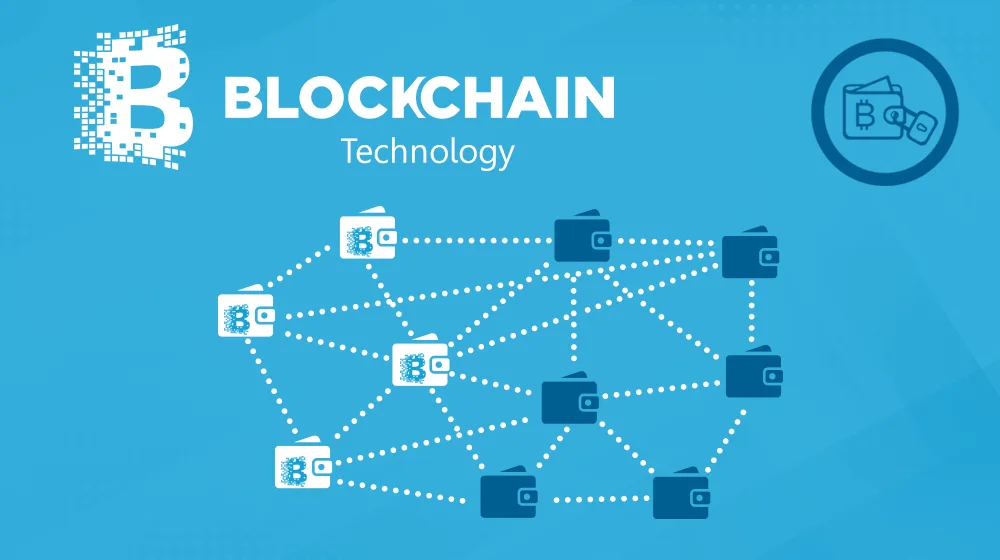There has been a lot of discussion and analysis on the future of Blockchain technology, but what is blockchain technology? Where does it fit into the future picture of the Internet and computers
What Is Blockchain?
Blockchain defined: Blockchain is a shared, immutable ledger. It facilitates the process of recording transactions. It also tracks assets in a business network.
Blockchain is the technology behind many cryptocurrencies, such as Bitcoin or Ethereum. However, its unique method of securely recording and transmitting information has wider applications than cryptocurrency.
A blockchain is a distributed ledger. The distributed ledger technology (DLT), allows record keeping across multiple computers. However, it requires a lot more computer power to operate. The ledger is managed by nodes that verify, approve and store data. This is in contrast to traditional record-keeping techniques that store data at a central location, such as a computer server.
Blockchain organizes data added to the ledger in blocks or groups. Each block can only contain a limited amount of information. Therefore, new blocks are added to the ledger continuously, creating a chain.
Each block is assigned a unique identifier (a cryptographic “hash”) that protects it from being accessed by anyone other than the code. It also protects its place in the chain by identifying any blocks before it.
The cryptographic hash, which is “a combination of numbers and letters that can have up to 64 digits in length. This is the code that allows all the pieces of the puzzle to fit together.
For the uninitiated, the term “blockchain” can mean several things. A person might hear the term and describe it in those terms, but it is really just one technology among many. I will attempt to provide an explanation as best I can based on my personal observations.
The underlying theme behind the term “blockchain” is software. The software that underlies the bitcoin protocol is referred to as “bitcoins”. This is software that acts like a digital ledger. This allows users of the technology to track and secure the public ledger that comprises the bitcoins, also referred to as the block chain.
The benefit of the bitcoin system is how it works. Every transaction that is made on the internet is made by a new network. Transactions are recorded in the form of transaction data, which is also stored as an electronic ledger. The nature of the digital ledger is such that any two copies of any particular transaction can be made and compared to see if they match. This helps to ensure that every transaction is secure and valid.
One of the ways that the bitcoin system is useful is through its ability to use digital signatures. A digital signature is a way for two people to agree upon the details of a specific transaction. A digital signature is created with a private key and a public key.
The private key is kept by the individual making the transaction, while the public key is stored by the entity that is making the transaction. Anyone making a transaction can verify that the transaction was made using a digital signature.
Another way that the bitcoin system works is through its peer-to-peer aspect. This is where users take part in transactions without having to wait for a third party to do so. Transactions can be sent directly between individuals or between entities. This is how the bitcoin system connects with the concept of the internet. The internet is where most transactions take place.
Another way that blockchain technology differs from that of the traditional finance industry is that instead of relying on the issuance of currency, the technology is instead based on trust. This means that instead of an agency issuing currency to each financial institution, the currency will exist on the blockchain only.
Every time a transaction occurs, it is required by the ledger that the correct balance is transferred from the existing balance to the new balance. This process is known as mining, and it is a crucial component of the blockchain.
Mining is what makes the bitcoin digital asset popular among investors, and it is also the reason why financial institutions are able to trade and use it as well.
In the end, if you’re interested in learning more about how the blockchain can help you with your day-to-day investments, there are several great resources online that can give you a lot of valuable information. For example, you can learn a lot more about how the blockchain can help you streamline transactions, and you can also find several great videos that explain the ins and outs of using the blockchain for your investment ventures.
Although the blockchain isn’t used by most financial institutions, building blocks for the future of the decentralised economy is something that is bound to happen sooner or later.
The History of Blockchain Technology
Blockchain history dates back further than most might think
Blockchain is more than a database. It’s a new technology stack that uses ‘digital trust’ to revolutionize the way we exchange information and value across the internet. This is done by removing the ‘gatekeepers’ from the process.
David Chaum, cryptographer, proposed the first protocol that resembles blockchain in 1982 However, Blockchain technology has its roots in the late 1970s when a computer scientist named Ralph Merkle patented Hash trees or Merkle trees.
Further work on a cryptographically secured chain of blocks was described in 1991 by Stuart Haber and W. Scott Stornetta.. However, it was Satoshi Nakamoto (presumed pseudonym for a person or group of people) who invented and implemented the first blockchain network after deploying the world’s first digital currency that we now know as Bitcoin.
How The Blockchain Works
Example of how blockchain is used to verify and record Bitcoin transactions.
- A consumer buys Bitcoin or Ethereum.
- The transaction data is sent across Bitcoin’s decentralized network of nodes.
- Nodes validate the transaction.
- After approval, the transaction is grouped with other transactions to form a block, which is added to an ever-growing chain of transactions.
- The completed block is encrypted, and the transaction record is permanent; it cannot be removed or altered on the blockchain.
Public Blockchains
Public blockchains are open, decentralized networks that allow anyone to validate or request a transaction. Miners who validate transactions get rewarded
Public blockchains can use proof-of work or proof-of stake consensus mechanisms (described later). The Bitcoin (ETH) and Ethereum (ETH), are two common examples of public Blockchains.
Bitcoin’s blockchain is public
The transaction record on Bitcoin’s blockchain can be viewed by anyone with Bitcoin. Although it is difficult to track the identity of an account, the transaction record will show which accounts are transacting on Bitcoin’s blockchain. Any user who has the necessary computer power can also participate in the approval and recording of transactions onto the public blockchain as a node.
However, not all blockchains can be made public. Private blockchains are possible to be created. This allows the owner to restrict who can add or change to the blockchain. Although the number of participants on private blockchains is smaller, they are still decentralized. Private blockchains use the same encryption methods to protect any data in the database.
A secure, permanent, decentralized record of information is a popular idea across many industries. It could provide solutions to many of the security issues, record-keeping processes and data ownership problems we are currently facing.
Private Blockchains
Private blockchains are not open, they have access restrictions. People who want to join require permission from the system administrator. They are typically governed by one entity, meaning they’re centralized.
Hybrid Blockchains or Consortiums
Consortiums combine public and private blockchains. They have both centralized and decentralized capabilities. R3, Energy Web Foundation, Dragonchain and Dragonchain are just a few examples.
There’s no consensus as to whether these terms are different. Some people make a distinction, while others see them as the same thing.
A Blockchain-Based Future
Blockchain technology allows us to securely move information, Agarwal said. You can also have almost complete confidence in the authenticity of any information you wish to protect.
Take, for instance, the stories of meme subjects or celebrities that made a fortune by selling non-fungible tokens (non-fungible tokens) in recent weeks.
NFTs enable sellers to verify the authenticity of digital assets because the underlying blockchain record cannot be altered. The transaction of buying an NFT is added to the blockchain ledger and becomes a verifiable record. Blockchain allows you to verify the authenticity of digital works and collectibles. This allows creators to retain value by earning royalties for digital art copies.
5 Blockchain Technology Use Cases
Blockchain technology is used in many industries, including supply chain, healthcare and retail, media, advertising, financial services and insurance, travel and transport, oil and gas, gaming, and media.
1. Cryptocurrencies: These let you transfer value faster and cheaper across borders without a bank. Besides Bitcoin and Ethereum, other digital currency examples include Polkadot (DOT), NEO, Cardano (ADA), Tether (USDT), Binance Coin (BNB), and Litecoin (LTC)
2. NFT marketplaces: These are marketplaces that allow you to buy nonfungible tokens (NFTs): digital tokens of things like paintings and clothing.
3. Video Games/Art: You may have heard Crypto Kitties—a game launched on the Ethereum blockchain. One of the virtual pets in the game was sold for over $100,000.
4. Decentralized Banking: The use of blockchain technology is also proliferating in banking. For example, many banks like Barclays, Canadian Imperial Bank, and UBS are interested in how blockchain can make their back-office settlement systems more efficient.
5. Personal identity security: Traditional systems for storing identities are insecure and fragmented. Blockchain provides a unified, immutable, and interoperable infrastructure so you can store and manage records securely and efficiently.
Employment Opportunities In Blockchain Technology Grow
It’s not about “What is Blockchain?” for organisations working at the intersection between technology and business
A Deloitte survey of 1,280 top executives and practitioners from around the globe found that 73% of them agreed with the statement “My organization will lose an opportunity to compete advantage if it doesn’t adopt Blockchain and Digital Assets.”
Blockchain has already improved the efficiency of businesses, including banking, finance, agriculture, supply chain, government, healthcare, and education. Blockchain is becoming an increasingly transferable skill as more organisations adopt it.
Blockchain has already improved business operations in a variety of industries, including banking, finance, agriculture, supply chain, government, healthcare, and education.
Blockchain is becoming an increasingly transferable skill as more organisations adopt it.
What are blockchain protocols?
Blockchain protocols refer to the various types of blockchain platforms available for application development. Each protocol adapts the fundamental blockchain principles to specific industries and applications. The following sections provide examples of different blockchain protocols:
- Corda
Corda is an open source blockchain project that’s designed for businesses. Corda allows you to create interoperable blockchain networks and transact in complete privacy. Corda’s smart contracts technology can be used by businesses to transact with value and directly. Financial institutions are the majority of Corda’s users.
- Hyperledger fabric
Hyperledger fabric is an open source project that includes a variety of tools and libraries. It can be used by enterprises to quickly and efficiently build private blockchain applications. It’s a modular framework with general purpose that provides unique access control and identity management features. It is suitable for many applications such as tracking supply chains, trade finance and loyalty and rewards.
- Quorum
Quorum, an open-source blockchain protocol, is derived form Ethereum. It can be used in either a private network where one member controls all nodes or in a consortium network where multiple members own a part of the network.
- Ethereum
Ethereum can be used to create public blockchain applications. It is an open-source, decentralized blockchain platform. Ethereum Enterprise is intended for business use.
What are the benefits of blockchain technology?
Blockchain technology offers many benefits for asset transaction management. Here are a few:
- Improved efficiency
Transactions between business and business can be slow and cause operational problems. This is especially true when third-party regulatory agencies and compliance are involved. These business transactions are faster and more efficient thanks to transparency and smart contracts in Blockchain.
- Advanced security
Blockchain systems offer the security and trust required for modern digital transactions. It is possible that an attacker could manipulate the underlying software to create fake money. Blockchain uses cryptography, consensus, and decentralization to create an extremely secure underlying system that is almost impossible to alter.
- Faster auditing
Enterprises need to be able securely create, exchange, archive, reconstruct, and audit e-transactions. Blockchain records can be viewed chronologically, so they are indistinguishable from other records. This transparency allows for faster audit processing.
What is Blockchain as a Service?
Blockchain as a Service (BaaS), is a managed blockchain service provided by a third party in the cloud. While the cloud provider provides the infrastructure and tools for building blockchain services, you can create blockchain applications and digital services. You can also customize existing blockchain technology to make it more effective and faster for blockchain adoption.
Extended Summary
Blockchain technology has seen a rise in popularity and usage over the past decade. It has begun to disrupt markets around Australia and the rest of the world. Nearly all economic sectors have been exposed to the potential of blockchain technology.
They have been studied, investigated, and even considered. Blockchain has attracted substantial public and private investment and introduced products and services that were previously unavailable across many industries.
Despite its potential, there is significant uncertainty regarding future adoption of blockchain technology around the globe.
These uncertainties raise the question: can blockchain progress beyond the hype to deliver tangible, high value applications and a thriving industry, or will blockchain amount to little more than a market bubble?







